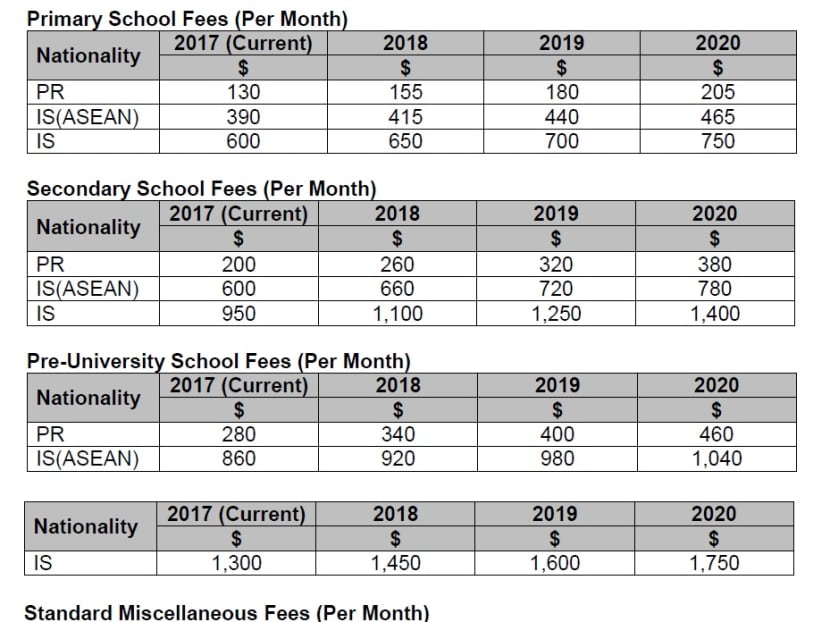School fees for foreigners, PRs to increase from 2018
SINGAPORE — For the third straight year, public school fees will be hiked in 2018 for foreigners and Permanent Residents (PRs), and more increases will follow in 2019 and 2020, the Ministry of Education (MOE) announced on Tuesday (Oct 17).

TODAY file photo
SINGAPORE — For the third straight year, public school fees will be hiked in 2018 for foreigners and Permanent Residents (PRs), and more increases will follow in 2019 and 2020, the Ministry of Education (MOE) announced on Tuesday (Oct 17).
This is the first time multiple increases have been announced after several rounds of fee hikes for non-Singaporeans in recent years, after Prime Minister Lee Hsien Loong, in September 2009, said the Government would sharpen the differentiation between citizens and non-citizens.
Since then, other measures have been implemented to distinguish the difference in benefits for Singaporeans. For instance, in 2012, the MOE gave Singaporeans “absolute priority” over PRs, if balloting is necessary in any phase of the Primary 1 registration. The Ministry of Health also lowered healthcare subsidies for PRs.
In a press release on Tuesday, the ministry said the fee increases will range from S$25 to S$150 per month for foreigners, and S$25 to S$60 per month for PRs, depending on the school level.
For instance, monthly fees for a permanent resident attending a primary school here will go up from S$130 now, to S$155 next year, to S$180 in 2019, and S$205 in 2020. For an international student in the same school, monthly fees will increase by S$50 each year, from S$600 now, to S$750 in 2020.
The MOE said the revision was part of its regular review of school fees.
“The release of the fee schedule for the next three years is to provide greater certainty on the fees for non-citizens for the next few years, and to enable parents to plan for the financing of their children’s studies in MOE schools,” it added.
The MOE also said there are currently no plans to adjust school fees for Singapore citizens. Singaporeans pay no school fees in primary school, but pay S$5 and S$6 monthly in secondary school and pre-university, respectively.
For some non-citizen parents who send their children to public schools, the higher school fees will be financially taxing, but most also noted that while the gap was narrowing, school fees international schools charge are still much higher — these range from around S$20,000 to S$35,000 a year.

(Click to enlarge) A breakdown of the revised school fees for non-citizens in government and government-aided schools from 2018 to 2020. Chart: MOE
Mr Fung Kok Ting, a permanent resident from Malaysia, has a 10-year-old daughter in Queenstown Primary School. The senior software engineer takes home around S$3,750 per month and said having to fork out more each month will be a burden on the family finances. However, Mr Fung, 36, noted that the school fees were still lower than that of international schools.
For instance, Dover Court International School Singapore charges S$25,200 annually – or S$2,100 monthly – for upper primary students, whereas the Australian International School charges S$33,646 annually – or S$2,804 monthly – for elementary school students.
Artist Kristine Oustrup Laureijs, a Danish citizen who moved to Singapore in 2009, has three children aged two, nine and 11. Her two elder children - both girls - are enrolled in Primary 3 and Primary 5 at Stamford Primary School and St Margaret’s Primary School respectively.
She felt that the growing discrepancy in school fees between Singaporeans and foreigners was a policy decision to make citizens feel “special”. “If the increase in school fees is so that the Government can invest more money to run the schools, then it’s understandable,” she added.
Her family is in the midst of applying for permanent residency, and intends to settle down in Singapore for the long term.
Ms Oustrup Laureijs, 45, said: “It makes sense for our children to go to a public school. It helps them understand local culture and have local friends, whereas in international schools, the students change every year.”
Earlier this month, Parliamentary Secretary for Education Low Yen Ling told Parliament that about 1,800 applications from international students to enter Primary 1 this year were rejected in the 2016 Primary 1 registration exercise.
TODAY had also reported that figures from the Immigration & Checkpoints Authority (ICA) show as of end-August, there were about 76,000 international students on Student’s Pass who are enrolled in private and government-run schools and institutions, including the polytechnics and universities in Singapore. In 2008, the number stood at close to 100,000, previous reports stated. The ICA issues the Student’s Pass for foreigners applying to study here.
Asked previously whether the ministry had turned away more applicants in the last few years and about the intake of foreign students, MOE would only say international students form about 5 per cent of the total student population in the last few years.






